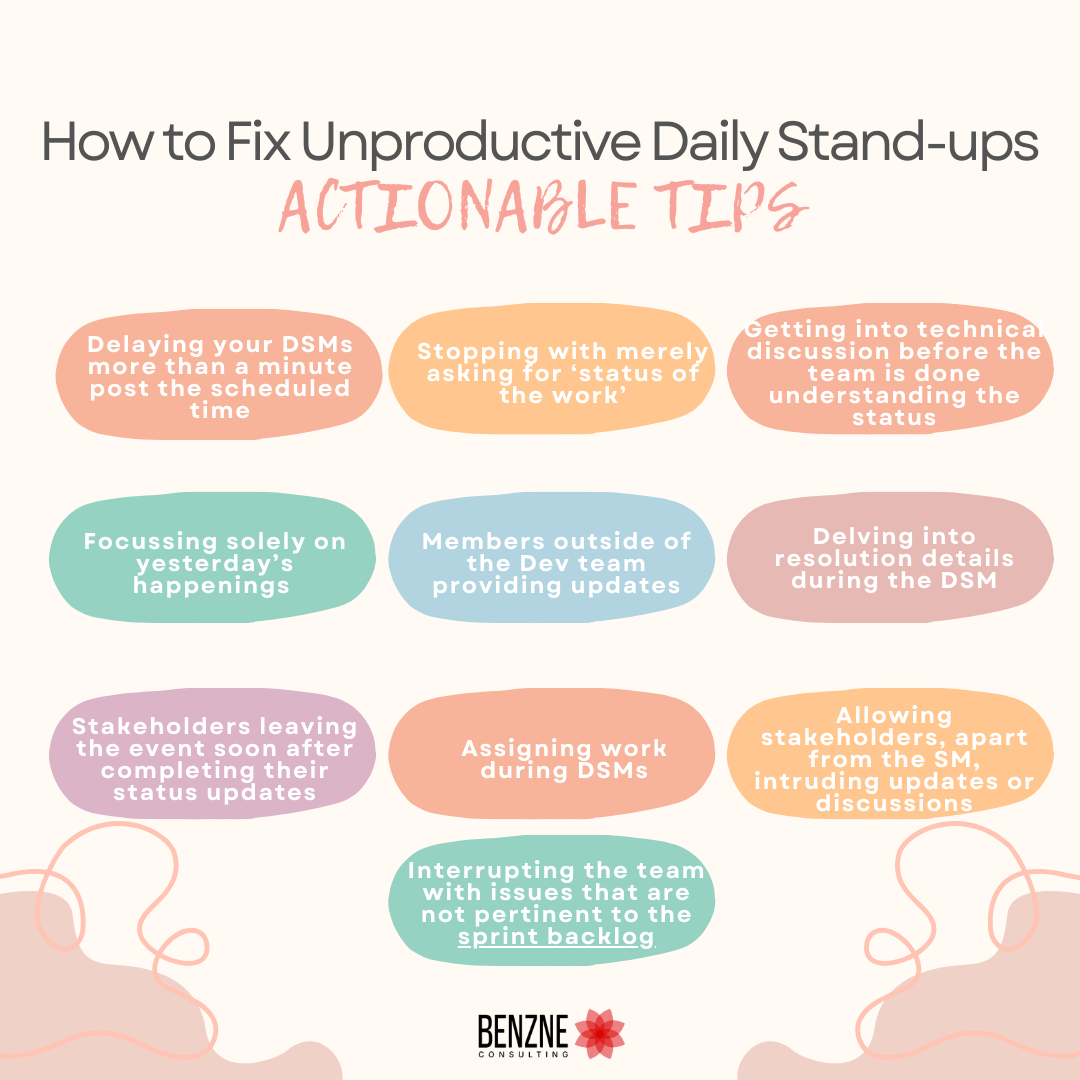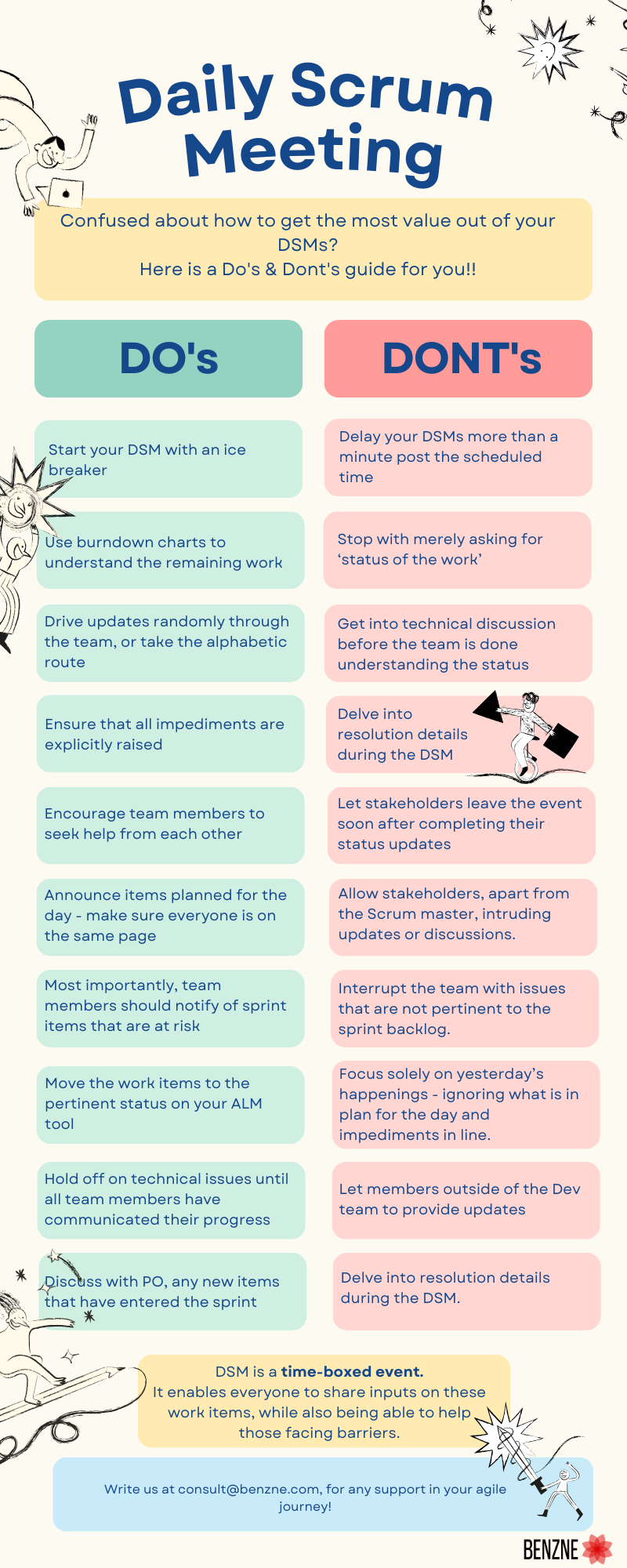Introduction to Daily Scrum Meetings
In an era where customer success and sentiment are paramount, reducing time to market is crucial for generating revenue and capturing market share. At the same time, in the age of VUCA (Volatile, Uncertain, Complex, Ambiguous), adopting and implementing Agile methodologies has become the key to success. To thrive, our project/program management or operations must embrace Agile principles and values, which focus on continuous inspection, adaptation, frequent software releases, psychological safety for team members, closer collaboration with the customer, and proactive risk and issue identification. Additionally, Agile encourages detailed planning for the near future.
To deliver frequently and at short intervals, accept change during the project, course-correct early, and build incrementally, it is essential for the team members or development team to meet daily. These meetings help plan each day, validate actual progress against the plan, course-correct swiftly, and eliminate blockers immediately. This meeting is none other than the Daily Scrum Meeting.
In this blog, I’ll explore the purpose of the Daily Scrum meeting, provide valuable pointers, and offer a format and agenda for conducting effective daily Scrum sessions. All of these insights are based purely on our consulting experience.
What is a Daily Scrum Meeting?
Let me first clarify these three words: Daily, Scrum, Meeting. As the terms suggest, these are daily recurring meetings conducted by the Scrum Team, for the Scrum Team, within the Scrum framework. During this meeting, developers and QA come together to revisit the plan created during Sprint Planning, assess the progress toward the Sprint Goal, check if the timelines are on track, discuss any deviations (if any), and identify and address any issues or blockers.
Now, you might wonder if this is similar to a Daily Standup Meeting. Well, the Daily Standup originated from the Daily Scrum. I often recommend using a Daily Standup meeting, regardless of the framework. The intent is to gather as a team to review progress against the plan and make quicker, earlier course corrections. Whether it’s a Daily Scrum or a Daily Standup, the purpose remains the same: to create planned opportunities for inspection and adaptation.
Objectives and Importance of Daily Scrum Meetings
The Daily Scrum meeting is held every day at the same time and place. In a virtual or distributed environment, the Daily Scrum is booked as a recurring event, typically lasting around 15 minutes, and is conducted by the Scrum team. The daily scrum meeting purpose is to foster openness. Lets see a few benefits below.
- The daily scrum meeting brings visibility. In other words, the Daily Scrum can serve as both a communication tool and an early warning indicator, as the team meets daily to discuss progress, identify where co-developers need help, and spot risks and issues at an early stage.
- The Daily Scrum also provides an opportunity for the Scrum team to track their progress. Team members move tasks in their chosen Agile tool to reflect their current status, showcasing completed work items.
- It’s highly rewarding for the team when they can see their tasks move from “To Do” to “In Progress” and finally to “Done.” This tangible progress reinforces the team’s momentum.
- Additionally, the Daily Scrum meeting provides confidence and reassurance to the Product Owner, as the team discusses the progress made toward the sprint goal.
- Another important benefit of the Daily Scrum meeting is that it allows developers and testers to understand when code will be integrated or ready for testing.
- Beyond tracking progress and identifying blockers, the Daily Scrum also promotes knowledge sharing among team members.
- This daily sync-up among team members strengthens the bond and fosters better collaboration within the team.
Daily Scrum Meeting Agenda
After planning the sprint on the first day of the iteration, the Scrum team begins their work. The Daily Scrum meeting agenda is to understand the progress made toward the committed sprint goal, make faster course corrections and identify blockers.
Participants of a Daily Scrum Meeting
Mandatory participants are the Scrum team, consisting of developers and testers. If designers are delivering designs that contribute to the sprint goal, they should also attend. For mature teams, the Scrum Master’s participation is optional. If the team needs the Scrum Master, they can invite them and seek help during the meeting. The Product Owner is also optional, as long as the Scrum team has functional clarity. If the Scrum team is dependent on another team, members of the dependent team can participate in the Daily Scrum meeting as well.
Daily Scrum Meeting Format
The Daily Scrum meeting is a short and focused meeting that takes place at the same time and place every day. One of the Scrum team members (every member takes turns to share the team board), or the Scrum Master, opens the team board in Jira or any other ALM tool. Each team member provides updates on their status, blockers, etc. The team member’s status being talked about must reflect on the ticket being worked upon on the Jira/ALM tool’s team board. Once everyone has shared their updates, the meeting ends.
The Daily scrum meeting format or agenda of the Daily Scrum should be called out at the beginning of every meeting until the Scrum team becomes accustomed to it. This repetition helps the team stay focused and ensures the meeting becomes a habitual, efficient part of their routine.
Daily Scrum Meeting Three Questions
During the Daily Scrum meeting, which is typically timeboxed to 15 minutes, each team member answers the following three questions which reflects the daily scrum meeting agenda:
- What did you work on since yesterday/our last meeting?
- What do you plan to accomplish today?
- Are there any blockers or impediments preventing you from meeting your sprint goal?
These three questions help other Scrum team members understand what the person has been working on and any blockers they may be facing. Once every team member has answered the questions, the meeting ends. If time remains, the Scrum team can discuss other relevant topics. This is the most common daily scrum meeting format.
Daily Scrum Meeting Rules
For an effective, focussed, outcome based DSM meeting, there are several norms to keep in mind. I prefer the term norms rather than Daily scrum meeting rules, as these are best decided by the Scrum team themselves. These norms apply to any meeting and should be followed consistently:
- The Daily Scrum (DSM meeting) must be scheduled as a recurring event in advance. Clearly mark who is mandatory and who is optional for the meeting.
- Reiterate the daily scrum meeting agenda every day until it becomes second nature for the team. Keep consistent daily scrum meeting format.
- What did you work on yesterday?
- What are you working on today?
- Do you have any blockers or impediments
- Avoid Interruptions when the team member is talking about the progress. Allow everyone the space to speak.
- DSM Meeting Is for the Scrum Team, not the Scrum Master or Product Owner,
updates should be directed to the team, not the Scrum Master or Product Owner. - The scrum team has a flat team structure meaning it operates without hierarchy.
Updates should be shared with the entire team,not just with managers or leadership. - Avoid Solutioning during the Daily Scrum Meeting. The meeting is not for problem solving or ideation.
- When discussing work items,always refer to the Jira board or the corresponding ALM tool to track progress. Avoid unguided conversations.
- The board must reflect the actual status of the work items being discussed at any given time.
- If issues arise during the Daily Scrum meeting, they should be addressed after the meeting to keep the discussion focused and concise.
Best Practices for Running Effective Daily Scrum Meetings /15 key Pointers That Could Help in Conducting an Effective DSM Meeting
- Start your DSM with an ice breaker
- Use burndown charts to understand the remaining work
- Drive updates randomly through the team, or take the alphabetic route
- Ensure that each team member starts off with what he / she is responsible to complete
- Ensure that all impediments are explicitly raised
- Encourage team members to seek help from each other
- Notify of items completed in the previous DSM
- Announce items planned for the day – make sure everyone is on the same page
- Most importantly, team members should notify of sprint items that are at risk
- Plan completion of the remaining items in the sprint
- Discuss with PO, any new items that have entered the sprint
- Offer help in resolving any impediments
- Move the work items to the pertinent status on your ALM tool
- Hold off on technical issues until all team members have communicated their progress
- All stakeholders should reserve queries and redressal of concerns till end of the DSM – possibly barring the scrum master and Dev team members
Duration and Timing of a Daily Scrum Meeting
As mentioned above, the Daily Scrum meeting duration must be timeboxed to no more than 15 minutes. In my opinion and based on my experience, the most effective Daily Scrum is one that is conducted at the beginning of the day. Holding the Daily Scrum at the start allows team members to review their daily tasks and organize themselves for the day ahead. At this time, people are generally more focused, productive, and alert. Running the meeting at the start of the day also gives the Scrum Master or Product Owner the entire day to address and resolve any blockers faced by the Scrum team.
How Updates Are Shared in a Daily Scrum Meeting
The Scrum Master, or one of the team members, opens the meeting on time. Based on the norms established by the team, one of the members opens the ALM tool( Jira), which displays the work items picked by the Scrum team (e.g., user stories, tasks needed to achieve the sprint goal).
Each team member then provides an update on their progress and answers the three questions mentioned earlier. The purpose of the Daily Scrum is to give everyone a rough idea of where the team stands. It is not meant to provide a complete inventory of everything happening in the project.
If someone mentions a blocker, it should be noted for follow-up after the meeting, either by the Scrum Master or the relevant team members.
Each member can refer to the ALM tool( Jira ) board when talking about their updates to ensure that everyone is aligned and understands the current status
Once all team members have provided their updates, the meeting should end. Make sure the discussion stays within the 15-minute timebox.
How to Fix Unproductive Daily Stand-ups: Actionable Tips/ 10 Key Pointers on What to Avoid While Conducting a Daily Scrum Meeting

- Delaying your DSMs more than a minute post the scheduled time
- Stopping with merely asking for ‘status of the work’
- Getting into technical discussion before the team is done understanding the status
- Focussing solely on yesterday’s happenings – ignoring what is in plan for the day and impediments in line
- Members outside of the Dev team providing updates
- Delving into resolution details during the DSM
- Stakeholders leaving the event soon after completing their status updates
- Assigning work during DSMs
- Allowing stakeholders, apart from the Scrum master, intruding updates or discussions
- Interrupting the team with issues that are not pertinent to the sprint backlog
Example of a Daily Scrum Meeting
In this Daily Scrum meeting example, the DSM Meeting is conducted on the 5th day of a 10-day sprint. The Scrum Team consists of 2 Developers and 1 QA Tester.
Sprint Duration: 10 days
Sprint Goal: Build a login page that takes the user to the product section (2 user stories)
DSM Time: 10:15 AM every day
Daily Scrum Update
Developer 1: “I am working on user story 2. I started creating a schema yesterday and have completed 70% of the user story. I will complete the remaining work by the end of day (EOD). As of now, I don’t have any blockers and no risks have been identified in achieving the sprint goal.”
Developer 2: “I completed the screen as per the plan and will be sending it for code review. I expect to complete the user story and address any code review comments. Meanwhile, I will discuss the designs with the designer. No risks seen in meeting the sprint goal.”
Tester: “I have completed the test scenarios for user story 3. I am currently fixing P4 bugs while I wait for the handover of user story 2 by EOD.”
Conclusion
Having explored the daily scrum meeting purpose, best practices, format and agenda for conducting the Daily Scrum meeting, it’s important to remember that, no matter what the meeting is called, the essence remains the same: to proactively identify issues and risks and adjust the course of the plan to meet the committed sprint goal whenever necessary. This is achieved through collaboration, open communication and team ownership of the sprint goal.
When dealing with detailed short-term planning and the need to deliver frequent, valuable software or functionality, short, focused meetings are not just a formality—they are a necessity. They enable rapid course correction and ensure the team remains aligned and on track to meet their objectives. The Daily Scrum serves as a key tool to keep the momentum going and ensures continuous improvement in the team’s delivery process.
Take help from agile consulting and training services companies like Benzne if you are struggling to bring in the required discipline and rigor in your daily scrum meetings. At Benzne agile consulting and training services as one one of the top agile consulting firms, has successfully transformed businesses with custom, tailored approaches to solve their problems like execution certainty, siloed mode of working, transparency, predictability, streamlining workflows and processes, scaling agile adoption, reduced time to market and increased customer satisfaction leveraging our indepth agile transformation experience.
With this our blog on “Daily Scrum Meeting (DSM) Guide : Do’s and Dont’s” comes to an end and we sincerely hope that the reading is worthwhile. Please write to us at consult@benzne.com for any suggestions or feedback.
FAQs About Daily Scrum Meetings
1. What is the main purpose of a daily scrum meeting?
The core agenda of daily scrum meeting is to ensure everyone in the scrum team is focused on the agreed-upon scope defined during the sprint planning meeting and check their progress made towards committed sprint /iteration goals. Additionally the daily scrum meeting purpose is to provide an early warning system for issues, allowing them to be resolved before they can derail the team’s progress.
2. Who should attend daily scrum meetings?
As mentioned above, mandatory participation is required from the Scrum team. The Scrum team consists of Developers and Testers, as per the latest version of the Scrum Guide. In some organizations, the Scrum Master and Product Owner are also mandated to attend daily Scrum meetings. In my opinion, however, as long as the Scrum team is self-organizing, empowered, and mature, the Product Owner, Scrum Master, and occasionally an SME/Tech Lead need not attend the Daily Scrum on a daily basis. The core scrum team is essential to be present to fulfil the agenda of daily scrum meeting.
3. How long should a daily scrum meeting last?
As per the Scrum Guide, the Daily Scrum meeting duration must be timeboxed to 15 minutes. The meeting space or time should be booked for 15 minutes. If the meeting lasts longer than this, the agenda of daily scrum meeting gets diluted, and team members tend to digress to other topics. The size of the Scrum team should ideally be no more than 8-9 members to keep communication short and clear. For this team size, if the focus is on answering the three key questions, the meeting should not exceed 15 minutes. In short, the Daily Scrum can last as short as 10 minutes or, at most, a minute or two longer than 15 minutes.
4. Can daily scrum meetings be conducted remotely?
For distributed teams, Daily Scrum meetings can indeed be conducted remotely using communication portals and ALM tools like Jira, Asana, etc. A recurring meeting invite is sent, and everyone joins the meeting virtually.
It’s essential to set some norms around how the Daily Scrum should be conducted. These norms should be decided and agreed upon by the Scrum team members to ensure the meeting remains focused, efficient, and effective.

